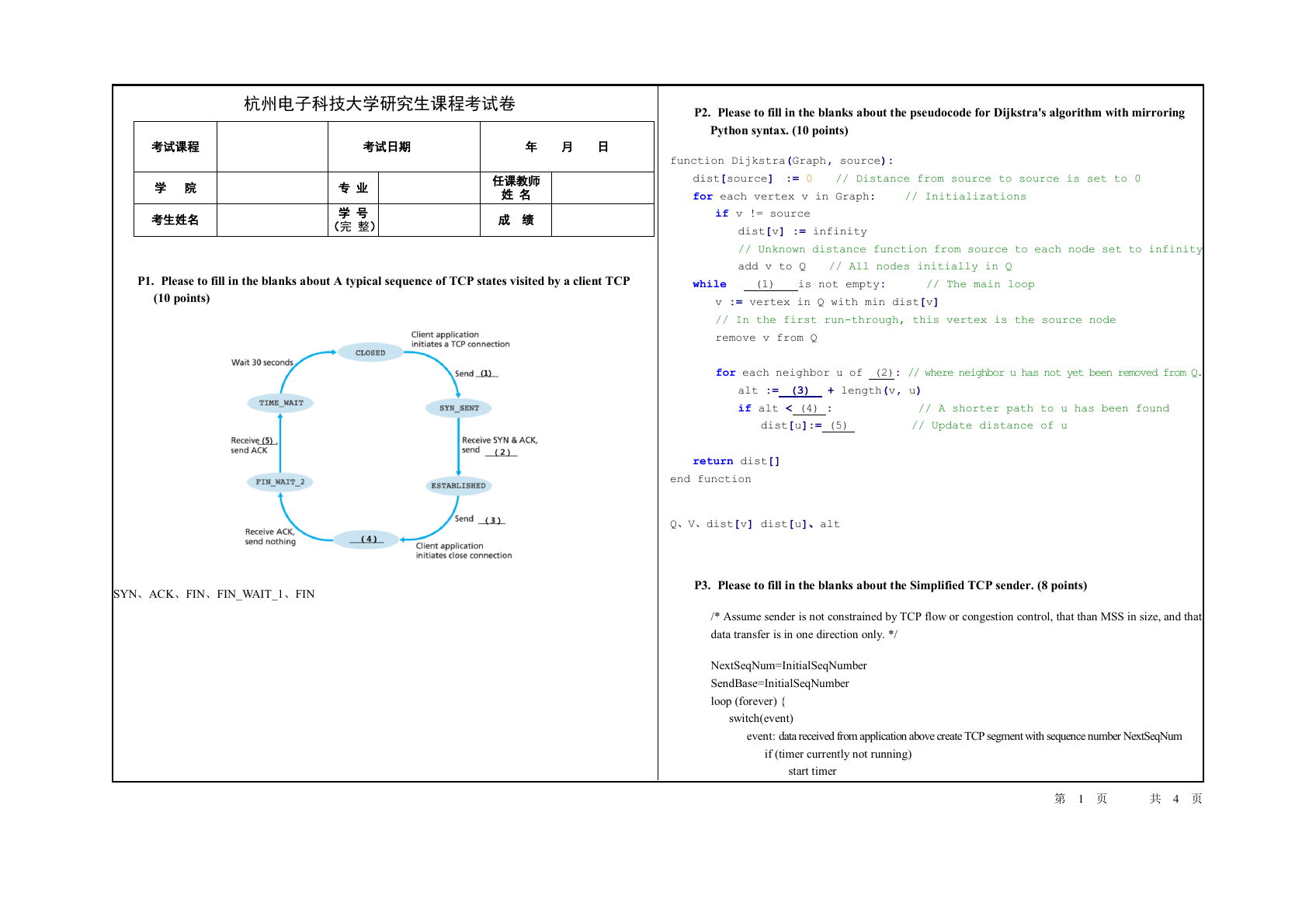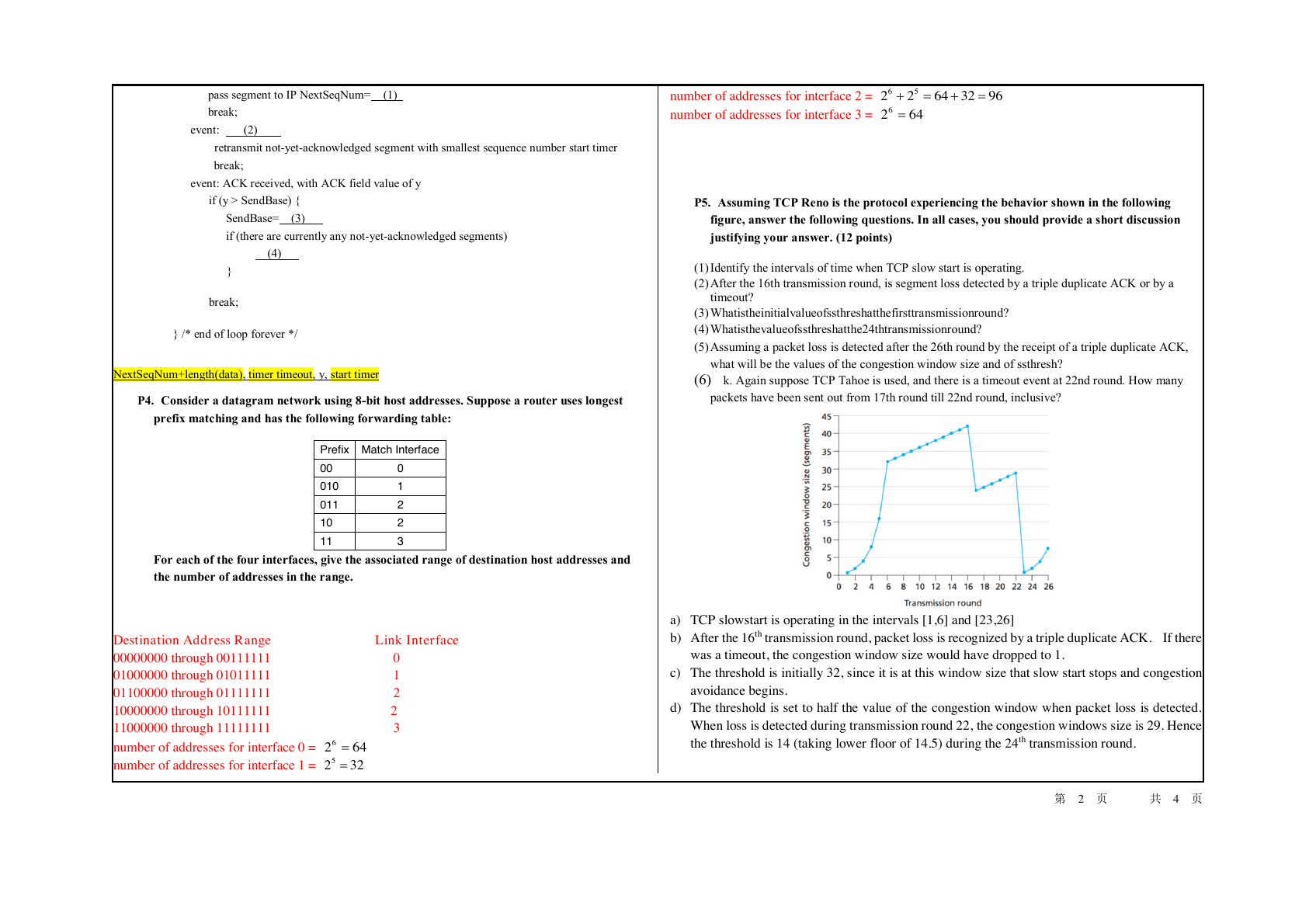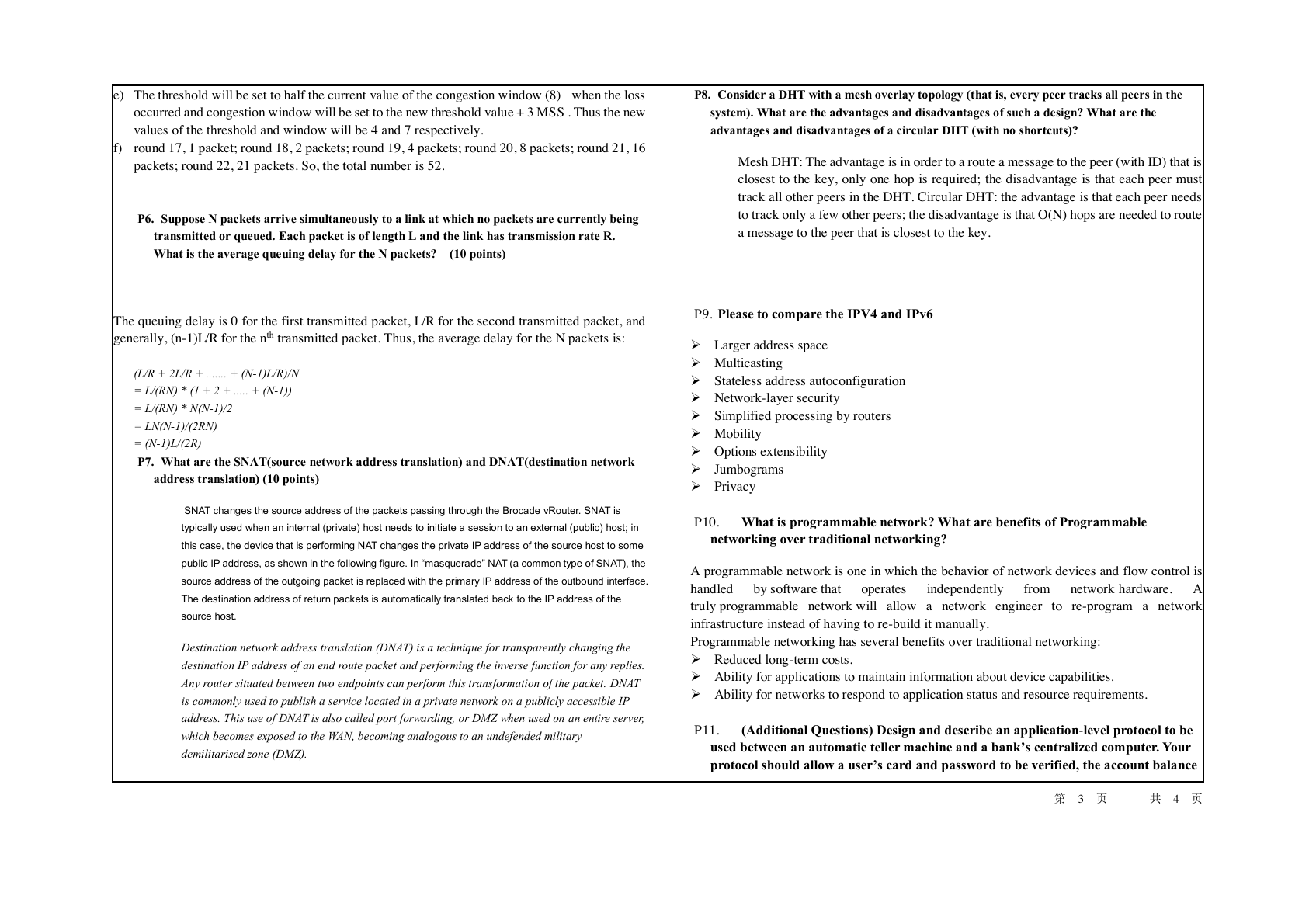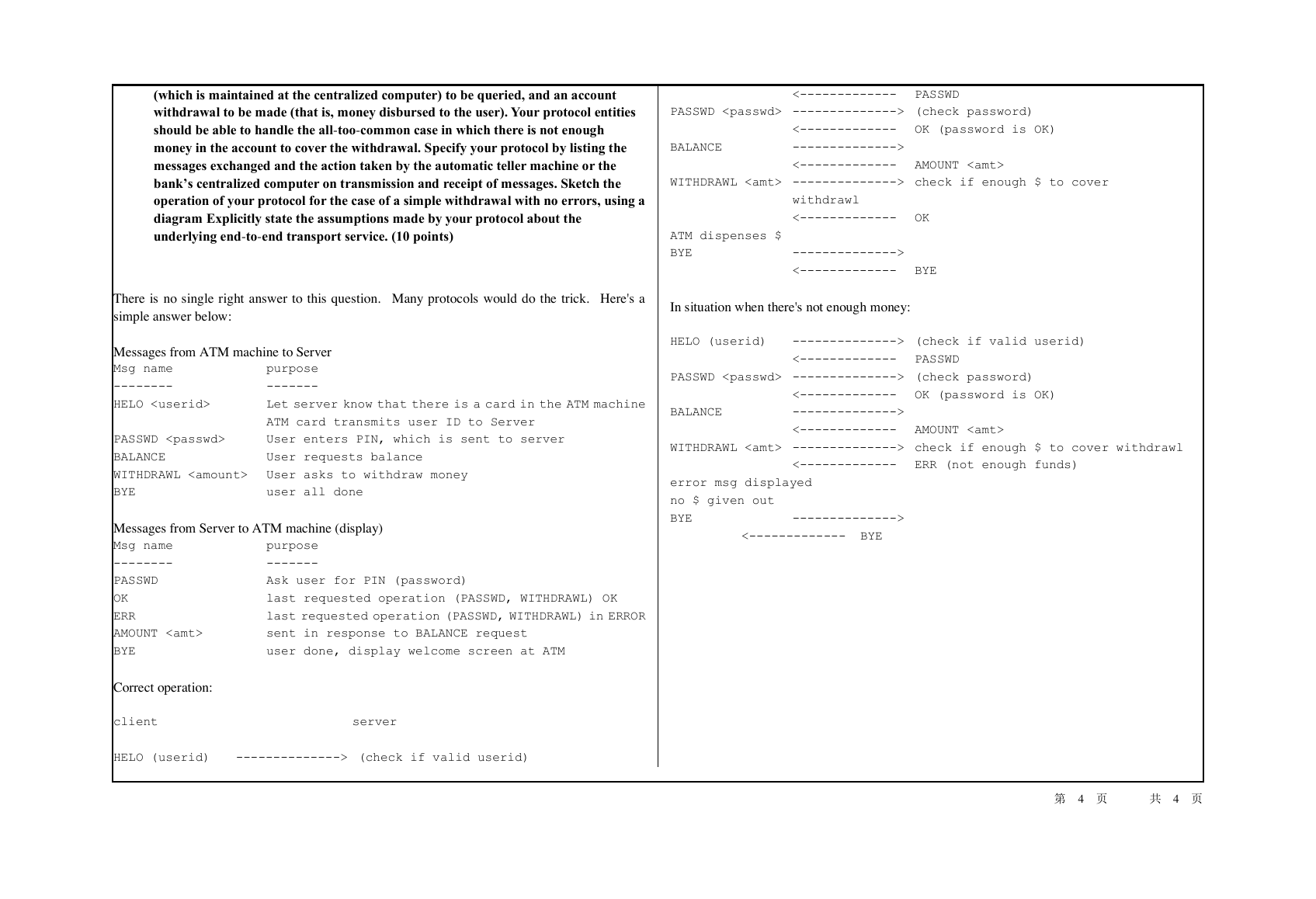杭州电子科技大学研究生课程考试卷
P2. Please to fill in the blanks about the pseudocode for Dijkstra's algorithm with mirroring
考试课程
学 院
考生姓名
考试日期
年 月 日
专 业
学 号
(完 整)
任课教师
姓 名
成 绩
P1. Please to fill in the blanks about A typical sequence of TCP states visited by a client TCP
(10 points)
Python syntax. (10 points)
function Dijkstra(Graph, source):
dist[source] := 0 // Distance from source to source is set to 0
for each vertex v in Graph: // Initializations
if v != source
dist[v] := infinity
// Unknown distance function from source to each node set to infinity
add v to Q // All nodes initially in Q
while (1) is not empty: // The main loop
v := vertex in Q with min dist[v]
// In the first run-through, this vertex is the source node
remove v from Q
for each neighbor u of (2): // where neighbor u has not yet been removed from Q.
alt := (3) + length(v, u)
if alt < (4) : // A shorter path to u has been found
dist[u]:= (5) // Update distance of u
return dist[]
end function
Q、V、dist[v] dist[u]、alt
SYN、ACK、FIN、FIN_WAIT_1、FIN
P3. Please to fill in the blanks about the Simplified TCP sender. (8 points)
/* Assume sender is not constrained by TCP flow or congestion control, that than MSS in size, and that
data transfer is in one direction only. */
NextSeqNum=InitialSeqNumber
SendBase=InitialSeqNumber
loop (forever) {
switch(event)
event: data received from application above create TCP segment with sequence number NextSeqNum
if (timer currently not running)
start timer
第 1 页 共 4 页
�
pass segment to IP NextSeqNum= (1)
break;
event: (2)
number of addresses for interface 2 =
number of addresses for interface 3 =
retransmit not-yet-acknowledged segment with smallest sequence number start timer
break;
event: ACK received, with ACK field value of y
if (y > SendBase) {
SendBase= (3)
P5. Assuming TCP Reno is the protocol experiencing the behavior shown in the following
figure, answer the following questions. In all cases, you should provide a short discussion
if (there are currently any not-yet-acknowledged segments)
justifying your answer. (12 points)
(4)
}
break;
} /* end of loop forever */
NextSeqNum+length(data), timer timeout, y, start timer
P4. Consider a datagram network using 8-bit host addresses. Suppose a router uses longest
prefix matching and has the following forwarding table:
Prefix Match Interface
00
010
011
10
11
0
1
2
2
3
For each of the four interfaces, give the associated range of destination host addresses and
the number of addresses in the range.
Link Interface
Destination Address Range
00000000 through 00111111 0
01000000 through 01011111 1
01100000 through 01111111 2
10000000 through 10111111 2
11000000 through 11111111 3
number of addresses for interface 0 =
number of addresses for interface 1 =
(1) Identify the intervals of time when TCP slow start is operating.
(2) After the 16th transmission round, is segment loss detected by a triple duplicate ACK or by a
timeout?
(3) Whatistheinitialvalueofssthreshatthefirsttransmissionround?
(4) Whatisthevalueofssthreshatthe24thtransmissionround?
(5) Assuming a packet loss is detected after the 26th round by the receipt of a triple duplicate ACK,
what will be the values of the congestion window size and of ssthresh?
(6) k. Again suppose TCP Tahoe is used, and there is a timeout event at 22nd round. How many
packets have been sent out from 17th round till 22nd round, inclusive?
a) TCP slowstart is operating in the intervals [1,6] and [23,26]
b) After the 16th transmission round, packet loss is recognized by a triple duplicate ACK. If there
was a timeout, the congestion window size would have dropped to 1.
c) The threshold is initially 32, since it is at this window size that slow start stops and congestion
avoidance begins.
d) The threshold is set to half the value of the congestion window when packet loss is detected.
When loss is detected during transmission round 22, the congestion windows size is 29. Hence
the threshold is 14 (taking lower floor of 14.5) during the 24th transmission round.
第 2 页 共 4 页
6426=3225=9632642256=+=+6426=�
e) The threshold will be set to half the current value of the congestion window (8) when the loss
occurred and congestion window will be set to the new threshold value + 3 MSS . Thus the new
values of the threshold and window will be 4 and 7 respectively.
f) round 17, 1 packet; round 18, 2 packets; round 19, 4 packets; round 20, 8 packets; round 21, 16
packets; round 22, 21 packets. So, the total number is 52.
P6. Suppose N packets arrive simultaneously to a link at which no packets are currently being
transmitted or queued. Each packet is of length L and the link has transmission rate R.
What is the average queuing delay for the N packets? (10 points)
The queuing delay is 0 for the first transmitted packet, L/R for the second transmitted packet, and
generally, (n-1)L/R for the nth transmitted packet. Thus, the average delay for the N packets is:
(L/R + 2L/R + ....... + (N-1)L/R)/N
= L/(RN) * (1 + 2 + ..... + (N-1))
= L/(RN) * N(N-1)/2
= LN(N-1)/(2RN)
= (N-1)L/(2R)
P7. What are the SNAT(source network address translation) and DNAT(destination network
address translation) (10 points)
SNAT changes the source address of the packets passing through the Brocade vRouter. SNAT is
typically used when an internal (private) host needs to initiate a session to an external (public) host; in
this case, the device that is performing NAT changes the private IP address of the source host to some
public IP address, as shown in the following figure. In “masquerade” NAT (a common type of SNAT), the
source address of the outgoing packet is replaced with the primary IP address of the outbound interface.
The destination address of return packets is automatically translated back to the IP address of the
source host.
Destination network address translation (DNAT) is a technique for transparently changing the
destination IP address of an end route packet and performing the inverse function for any replies.
Any router situated between two endpoints can perform this transformation of the packet. DNAT
is commonly used to publish a service located in a private network on a publicly accessible IP
address. This use of DNAT is also called port forwarding, or DMZ when used on an entire server,
which becomes exposed to the WAN, becoming analogous to an undefended military
demilitarised zone (DMZ).
P8. Consider a DHT with a mesh overlay topology (that is, every peer tracks all peers in the
system). What are the advantages and disadvantages of such a design? What are the
advantages and disadvantages of a circular DHT (with no shortcuts)?
Mesh DHT: The advantage is in order to a route a message to the peer (with ID) that is
closest to the key, only one hop is required; the disadvantage is that each peer must
track all other peers in the DHT. Circular DHT: the advantage is that each peer needs
to track only a few other peers; the disadvantage is that O(N) hops are needed to route
a message to the peer that is closest to the key.
P9. Please to compare the IPV4 and IPv6
➢ Larger address space
➢ Multicasting
➢ Stateless address autoconfiguration
➢ Network-layer security
➢ Simplified processing by routers
➢ Mobility
➢ Options extensibility
➢ Jumbograms
➢ Privacy
P10. What is programmable network? What are benefits of Programmable
networking over traditional networking?
independently
from
operates
by software that
A programmable network is one in which the behavior of network devices and flow control is
handled
network hardware. A
truly programmable network will allow a network engineer to re-program a network
infrastructure instead of having to re-build it manually.
Programmable networking has several benefits over traditional networking:
➢ Reduced long-term costs.
➢ Ability for applications to maintain information about device capabilities.
➢ Ability for networks to respond to application status and resource requirements.
P11.
(Additional Questions) Design and describe an application-level protocol to be
used between an automatic teller machine and a bank’s centralized computer. Your
protocol should allow a user’s card and password to be verified, the account balance
第 3 页 共 4 页
�
(which is maintained at the centralized computer) to be queried, and an account
withdrawal to be made (that is, money disbursed to the user). Your protocol entities
should be able to handle the all-too-common case in which there is not enough
money in the account to cover the withdrawal. Specify your protocol by listing the
messages exchanged and the action taken by the automatic teller machine or the
bank’s centralized computer on transmission and receipt of messages. Sketch the
operation of your protocol for the case of a simple withdrawal with no errors, using a
diagram Explicitly state the assumptions made by your protocol about the
underlying end-to-end transport service. (10 points)
There is no single right answer to this question. Many protocols would do the trick. Here's a
simple answer below:
Messages from ATM machine to Server
Msg name
purpose
--------
-------
HELO
Let server know that there is a card in the ATM machine
ATM card transmits user ID to Server
PASSWD
User enters PIN, which is sent to server
BALANCE
User requests balance
WITHDRAWL User asks to withdraw money
BYE
user all done
Messages from Server to ATM machine (display)
Msg name
purpose
--------
PASSWD
OK
ERR
-------
Ask user for PIN (password)
last requested operation (PASSWD, WITHDRAWL) OK
last requested operation (PASSWD, WITHDRAWL) in ERROR
AMOUNT
sent in response to BALANCE request
BYE
user done, display welcome screen at ATM
Correct operation:
client server
HELO (userid)
--------------> (check if valid userid)
<------------- PASSWD
PASSWD --------------> (check password)
<------------- OK (password is OK)
BALANCE
-------------->
<------------- AMOUNT
WITHDRAWL --------------> check if enough $ to cover
withdrawl
<------------- OK
ATM dispenses $
BYE
-------------->
<------------- BYE
In situation when there's not enough money:
HELO (userid)
--------------> (check if valid userid)
<------------- PASSWD
PASSWD --------------> (check password)
<------------- OK (password is OK)
BALANCE
-------------->
<------------- AMOUNT
WITHDRAWL --------------> check if enough $ to cover withdrawl
<------------- ERR (not enough funds)
error msg displayed
no $ given out
BYE
-------------->
<------------- BYE
第 4 页 共 4 页
�








 2023年江西萍乡中考道德与法治真题及答案.doc
2023年江西萍乡中考道德与法治真题及答案.doc 2012年重庆南川中考生物真题及答案.doc
2012年重庆南川中考生物真题及答案.doc 2013年江西师范大学地理学综合及文艺理论基础考研真题.doc
2013年江西师范大学地理学综合及文艺理论基础考研真题.doc 2020年四川甘孜小升初语文真题及答案I卷.doc
2020年四川甘孜小升初语文真题及答案I卷.doc 2020年注册岩土工程师专业基础考试真题及答案.doc
2020年注册岩土工程师专业基础考试真题及答案.doc 2023-2024学年福建省厦门市九年级上学期数学月考试题及答案.doc
2023-2024学年福建省厦门市九年级上学期数学月考试题及答案.doc 2021-2022学年辽宁省沈阳市大东区九年级上学期语文期末试题及答案.doc
2021-2022学年辽宁省沈阳市大东区九年级上学期语文期末试题及答案.doc 2022-2023学年北京东城区初三第一学期物理期末试卷及答案.doc
2022-2023学年北京东城区初三第一学期物理期末试卷及答案.doc 2018上半年江西教师资格初中地理学科知识与教学能力真题及答案.doc
2018上半年江西教师资格初中地理学科知识与教学能力真题及答案.doc 2012年河北国家公务员申论考试真题及答案-省级.doc
2012年河北国家公务员申论考试真题及答案-省级.doc 2020-2021学年江苏省扬州市江都区邵樊片九年级上学期数学第一次质量检测试题及答案.doc
2020-2021学年江苏省扬州市江都区邵樊片九年级上学期数学第一次质量检测试题及答案.doc 2022下半年黑龙江教师资格证中学综合素质真题及答案.doc
2022下半年黑龙江教师资格证中学综合素质真题及答案.doc